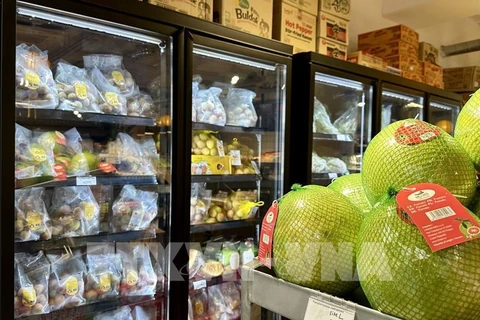
Hanoi (VNA) - With the world market’s recovery and increased export orders, import and export activities in the first five months of 2024 continued to thrive and saw considerable outcomes.
In May, total import and export turnover was estimated to reach 66.62 billion USD, up 9.1% from the previous month and 22.6% over the same period last year. In the January-May period, the total import-export turnover reached 305.53 billion USD, a year-on-year increase of 16.6%.
Exports soar in all three groups of goods
The Ministry of Industry and Trade's report shows that in May, exports were estimated to reach 32.81 billion USD, up 5.7% month on month and 15.8% year on year.
In the first five months, the total export turnover was estimated to reach 156.77 billion USD, up 15.2% over the same period last year.
Notably, in the past five months, exports grew strongly in all three product groups. The agricultural product group has maintained growth from 2023, with total export turnover estimated at 15.18 billion USD, up 22% annually, accounting for 9.68% of the country’s total export value.
Thanks to export price hikes, most items in the group recorded a double digital export value, including coffee (up 43.9%), rice (38.2%), tea (20.1%), vegetables and fruit (28.2%), cashew nuts (19.3%), pepper (19.7%,), and cassava (19.2%).
Also in May, the processing and manufacturing industrial product group raked in about 132.42 billion USD, up 14.9% year on year, accounting for 84.5% of total export turnover. In addition, export turnover of the mineral fuel group was estimated to reach 1.96 billion USD, up 16.2% over the same period last year.

During the January-May period, the US remained Vietnam’s largest importer with turnover reaching 43.98 billion USD, or 28% of the country’s export value, up 21% annually. It was followed by China with 22.65 billion USD, up 10.2%, and the EU with 20.69 billion USD, up 16.1%.
Competitive advantages maintained
Meanwhile, imports in May were estimated to reach 33.81 billion USD, up 12.8% month on month. In the last five months, the country spent about 148.76 billion USD in goods import, a year-on-year increase of 18.2%.
As a result, Vietnam suffered an estimated trade deficit of 1 billion USD, marking May as the first month in nearly two years where there wasn’t a trade surplus.
However, according to a representative from the Ministry of Industry and Trade, this is a positive signal for the economy amidst rising domestic production and consumption, and a sharp increase in demand for imported raw materials, machinery and equipment for production, serving newly signed orders.
The trade surplus hit 8.01 billion USD in the January – May period.
According to the Ministry of Industry and Trade, Vietnam's import and export activities in 2024, especially exports to key markets such as Europe and America, will do well thanks to existing Free Trade Agreements (FTAs).
In addition, industrialised countries continue to promote strategies to diversify sources of supply chains, and investments will help Vietnam become an important production and export centre in the global value chain. Therefore, to maintain growth according to the target set at the beginning of the year (at about 6%), the Ministry of Industry and Trade has directed functional units to closely monitor market developments.
They are to continue to provide prompt information on export markets for trade associations, helping businesses adjust production plans and seek orders from markets.
For the farm produce sector, Minister of Industry and Trade Nguyen Hong Dien asked ministry units to continue providing support for trade promotion and brand building. They are also instructed to provide intruction the use of geographical indicators to help increase market share in traditional markets, expand niche markets and penentrate new, potential markets.

Units are urged to coordinate with relevant ministries, sectors, localities and associations to support enterprises to explore preferentials from the FTAs. They need to offer assistance for businesspersons to improve business capacity, necessary skills in negotiations, signing, implementation of export orders, and the settlement of trade defense lawsuits and international trade disputes./.






















